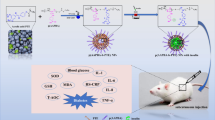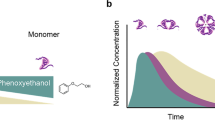Abstract
Insulin aggregation is the leading cause of considerable reduction in the amount of active drug molecules in liquid formulations manufactured for diabetes management. Phenolic compounds, such as phenol and m-cresol, are routinely used to stabilize insulin in a hexameric form during its commercial preparation. However, long term usage of commercial insulin results in various adverse secondary responses, for which toxicity of the phenolic excipients is primarily responsible. In this study we aimed to find out a nontoxic insulin stabilizer. To that end, we have selected resveratrol, a natural polyphenol, as a prospective nontoxic insulin stabilizer because of its structural similarity with commercially used phenolic compounds. Atomic force microscopy visualization of resveratrol-treated human insulin revealed that resveratrol has a unique ability to arrest hINS in a soluble oligomeric form having discrete spherical morphology. Most importantly, resveratrol-treated insulin is nontoxic for HepG2 cells and it effectively maintains low blood glucose in a mouse model. Cryo-electron microscopy revealed 3D morphology of resveratrol-stabilized insulin that strikingly resembles crystal structures of insulin hexamer formulated with m-cresol. Significantly, we found that, in a condition inductive to amyloid fibrillation at physiological pH, resveratrol is capable of stabilizing insulin more efficiently than m-cresol. Thus, this study describes resveratrol as an effective nontoxic natural molecule that can be used for stabilizing insulin in a bioactive oligomeric form during its commercial formulation.
Graphic Abstract







Similar content being viewed by others
References
Jars MU, Hvass A, Waaben D (2002) Insulin aspart (AspB28 human insulin) derivatives formed in pharmaceutical solutions. Pharm Res 19:621–628
Woods RJ, Alarcon J, McVey E, Pettis RJ (2012) Intrinsic fibrillation of fast-acting insulin analogs. J Diabetes Sci Technol 6:265–276
Brange J, Andersen L, Laursen ED, Meyn G, Rasmussen E (1997) Toward understanding insulin fibrillation. J Pharm Sci 86:517–525
Dische FE, Wernstedt C, Westermark GT, Westermark P, Pepys MB, Rennie JA, Gilbey SG, Watkins PJ (1988) Insulin as an amyloid-fibril protein at sites of repeated insulin injections in a diabetic patient. Diabetologia 31:158–161
Ratha BN, Ghosh A, Brender JR, Gayen N, Ilyas H, Neeraja C, Das KP, Mandal AK, Bhunia A (2016) Inhibition of insulin amyloid fibrillation by a novel amphipathic heptapeptide: mechanistic details studied by spectroscopy in combination with microscopy. J Biol Chem 291:23545–23556
Bryant C, Spencer DB, Miller A, Bakaysa DL, McCune KS, Maple SR, Pekar AH, Brems DN (1993) Acid stabilization of insulin. Biochemistry 32:8075–8082
Dunn MF (2005) Zinc-ligand interactions modulate assembly and stability of the insulin hexamer—a review. Biometals 18:295–303
Teska BM, Alarcon J, Pettis RJ, Randolph TW, Carpenter JF (2014) Effects of phenol and meta-cresol depletion on insulin analog stability at physiological temperature. J Pharm Sci 103:2255–2267
Derewenda U, Derewenda Z, Dodson EJ, Dodson GG, Reynolds CD, Smith GD, Sparks C, Swenson D (1989) Phenol stabilizes more helix in a new symmetrical zinc insulin hexamer. Nature 338:594–596
Smith GD, Dodson GG (1992) Structure of a rhombohedral R6 insulin/phenol complex. Proteins 14:401–408
Whittingham JL, Edwards DJ, Antson AA, Clarkson JM, Dodson GG (1998) Interactions of phenol and m-cresol in the insulin hexamer, and their effect on the association properties of B28 pro → Asp insulin analogues. Biochemistry 37:11516–11523
Whittingham JL, Chaudhuri S, Dodson EJ, Moody PC, Dodson GG (1995) X-ray crystallographic studies on hexameric insulins in the presence of helix-stabilizing agents, thiocyanate, methylparaben, and phenol. Biochemistry 34:15553–15563
Smith GD, Ciszak E, Pangborn W (1996) A novel complex of a phenolic derivative with insulin: structural features related to the T→R transition. Protein Sci 5:1502–1511
Jarosz-Chobot P, Nowakowska M, Polanska J (2007) Seeking the factors predisposing to local skin inflammatory state development in children with type 1 diabetes (T1DM) treated with continuous subcutaneous insulin infusion (CSII). Exp Clin Endocrinol diabetes 115:179–181
Weber C, Kammerer D, Streit B, Licht AH (2015) Phenolic excipients of insulin formulations induce cell death, pro-inflammatory signaling and MCP-1 release. Toxicol Rep 2:194–202
Johansson UB, Adamson U, Lins PE, Wredling R (2005) Patient management of long-term continuous subcutaneous insulin infusion. J Adv Nurs 51:112–118
Sanders JM, Bucher JR, Peckham JC, Kissling GE, Hejtmancik MR, Chhabra RS (2009) Carcinogenesis studies of cresols in rats and mice. Toxicology 257:33–39
Waugh DF (1957) A mechanism for the formation of fibrils from protein molecules. J Cell Physiol Suppl 49:145–164
Selivanova OM, Galzitskaya OV (2012) Structural polymorphism and possible pathways of amyloid fibril formation on the example of insulin protein. Biochemistry (Mosc) 77:1237–1247
Yoshihara H, Saito J, Tanabe A, Amada T, Asakura T, Kitagawa K, Asada S (2016) Characterization of novel insulin fibrils that show strong cytotoxicity under physiological pH. J Pharm Sci 105:1419–1426
Tang G, Peng L, Baldwin PR, Mann DS, Jiang W, Rees I, Ludtke SJ (2007) EMAN2: an extensible image processing suite for electron microscopy. J Struct Biol 157:38–46
Grigorieff N (2007) FREALIGN: high-resolution refinement of single particle structures. J Struct Biol 157:117–125
Grant T, Rohou A, Grigorieff N (2018) cisTEM, user-friendly software for single-particle image processing. eLife. 7:e35383
Sorzano CO, Marabini R, Velazquez-Muriel J, Bilbao-Castro JR, Scheres SH, Carazo JM, Pascual-Montano A (2004) XMIPP: a new generation of an open-source image processing package for electron microscopy. J Struct Biol 148:194–204
Shaikh TR, Gao H, Baxter WT, Asturias FJ, Boisset N, Leith A, Frank J (2008) SPIDER image processing for single-particle reconstruction of biological macromolecules from electron micrographs. Nat Protoc 3:1941–1974
Trabuco LG, Villa E, Schreiner E, Harrison CB, Schulten K (2009) Molecular dynamics flexible fitting: a practical guide to combine cryo-electron microscopy and X-ray crystallography. Methods 49:174–180
Afgan E, Baker D, Batut B, van den Beek M, Bouvier D, Cech M, Chilton J, Clements D, Coraor N, Gruning BA, Guerler A, Hillman-Jackson J, Hiltemann S, Jalili V, Rasche H, Soranzo N, Goecks J, Taylor J, Nekrutenko A, Blankenberg D (2018) The Galaxy platform for accessible, reproducible and collaborative biomedical analyses: 2018 update. Nucleic Acids Res 46:W537–W544
Schneidman-Duhovny D, Inbar Y, Nussinov R, Wolfson HJ (2005) PatchDock and SymmDock: servers for rigid and symmetric docking. Nucleic Acids Res 33:W363–W367
Morris GM, Huey R, Lindstrom W, Sanner MF, Belew RK, Goodsell DS, Olson AJ (2009) AutoDock4 and AutoDockTools4: automated docking with selective receptor flexibility. J Comput Chem 30:2785–2791
Grosdidier A, Zoete V, Michielin O (2011) SwissDock, a protein-small molecule docking web service based on EADock DSS. Nucleic Acids Res 39:W270–W277
Pettersen EF, Goddard TD, Huang CC, Couch GS, Greenblatt DM, Meng EC, Ferrin TE (2004) UCSF Chimera—a visualization system for exploratory research and analysis. J Comput Chem 25:1605–1612
Ehrnhoefer DE, Bieschke J, Boeddrich A, Herbst M, Masino L, Lurz R, Engemann S, Pastore A, Wanker EE (2008) EGCG redirects amyloidogenic polypeptides into unstructured, off-pathway oligomers. Nat Struct Mol Biol 15:558–566
Gong H, He Z, Peng A, Zhang X, Cheng B, Sun Y, Zheng L, Huang K (2014) Effects of several quinones on insulin aggregation. Sci Rep 4:5648
Smith GD, Ciszak E, Magrum LA, Pangborn WA, Blessing RH (2000) R6 hexameric insulin complexed with m-cresol or resorcinol. Acta Crystallogr D Biol Crystallogr 56:1541–1548
Mishra R, Sellin D, Radovan D, Gohlke A, Winter R (2009) Inhibiting islet amyloid polypeptide fibril formation by the red wine compound resveratrol. ChemBioChem 10:445–449
Dhouafli Z, Cuanalo-Contreras K, Hayouni EA, Mays CE, Soto C, Moreno-Gonzalez I (2018) Inhibition of protein misfolding and aggregation by natural phenolic compounds. Cell Mol Life Sci 75:3521–3538
Costabile G, Vitale M, Luongo D, Naviglio D, Vetrani C, Ciciola P, Tura A, Castello F, Mena P, Del Rio D, Capaldo B, Rivellese AA, Riccardi G, Giacco R (2018) Grape pomace polyphenols improve insulin response to a standard meal in healthy individuals: A pilot study. Clin Nutr 38:2727–2734
Acknowledgements
This work was supported by SERB, DST (India) sponsored project, DBT contingency fund for Research Associate (DBT-RA, India), and CSIR-Indian Institute of Chemical Biology, Kolkata, India. BP sincerely thanks DBT for providing Research associate Fellowship. We acknowledge the Central Instrument Facility (CIF) (and all the technical staff associated with it) of CSIR-IICB for their help in all respect. We sincerely thank Dr. Ilic Zoran of Wadsworth Center, NY, USA, for critically checking the manuscript and Mr. Chiranjit Biswas for cryo-EM data collection. DD and SB acknowledge UGC and CSIR (India), respectively, for Senior Research Fellowship. Financial support from the DBT-RA Program in Biotechnology and Life Sciences is gratefully acknowledged.
Author information
Authors and Affiliations
Contributions
BP and JS conceived the project and designed the experiments. BP carried out biochemical and biophysical experiments and 3D image processing of cryo-EM data. DD performed cell-based and animal experiments under the supervision of PC. SB assisted in cryo-EM data processing. BP, DD, PC and JS analyzed the data and wrote the manuscript.
Corresponding authors
Additional information
Publisher's Note
Springer Nature remains neutral with regard to jurisdictional claims in published maps and institutional affiliations.
Accession numbers
The cryo-EM density map of reveratrol-stabilized oligomeric form of insulin was deposited in the Electron Microscopy Data Bank (EMDB) under the accession number EMD-9878, and the fitted model was deposited in the RCSB Protein Data Bank (PDB) under the accession code 6JR3.
Electronic supplementary material
Below is the link to the electronic supplementary material.
Rights and permissions
About this article
Cite this article
Pathak, B.K., Das, D., Bhakta, S. et al. Resveratrol as a nontoxic excipient stabilizes insulin in a bioactive hexameric form. J Comput Aided Mol Des 34, 915–927 (2020). https://doi.org/10.1007/s10822-020-00311-3
Received:
Accepted:
Published:
Issue Date:
DOI: https://doi.org/10.1007/s10822-020-00311-3




